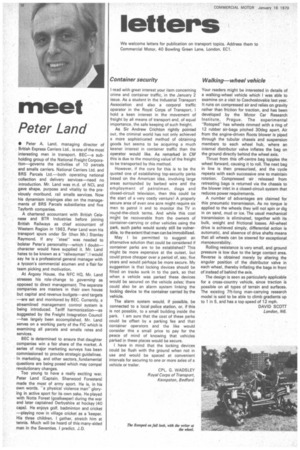Walking—wheel vehicle
Page 40

If you've noticed an error in this article please click here to report it so we can fix it.
Your readers might be interested in details of a walking-wheel vehicle which I was able to examine on a visit to Czechoslovakia last year. It runs on compressed air and relies on gravity rather than friction for traction, and has been developed by the Motor Car Research Institute, Prague. The experimental "Rotoped" has wheels rimmed with a ring of 12 rubber air-bags pitched 30deg apart. Air from the engine-driven Roots blower is piped through the tubular chassis and suspension members to each wheel hub, where an internal distributor valve inflates the bag on the ground directly behind the wheel axis.
Thrust from this off-centre bag topples the wheel forward, causing it to roll. The next bag in line is then pressurized, and the cycle repeats with each successive one to maintain rotation. Compressed air released from retreating bags is returned via the chassis to the blower inlet in a closed-circuit system that reduces power requirements.
A number of advantages are claimed for this pneumatic transmission. As no torque is applied to the wheels they will not spin or dig in on sand, mud or ice. The usual mechanical transmission is eliminated, together with its bulk, weight and frictional losses. All-wheel drive is achieved simply, differential action is automatic, and absence of drive shafts means that all wheels can be steered for exceptional ma noeuvrability.
Rolling resistance is very small, and ground pressure is low due to the large contact area. Reverse is obtained merely by altering the angular position of the distributor valve in each wheel, thereby inflating the bags in front of instead of behind the axis.
The design is seen as particularly applicable for a cross-country vehicle, since traction is possible on all types of terrain and surfaces. The existing 7ft-long man-carrying research model is said to be able to climb gradients up to 1 in 5, and has a top speed of 12 mph.
DAVID SCOTT London, N6.
































































































